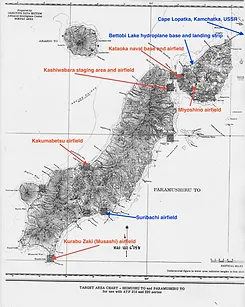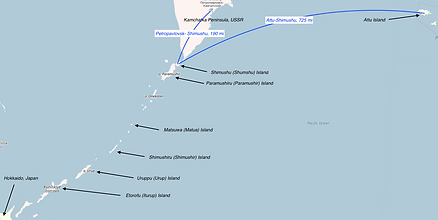Japanese Air Fields at Northern Kuriles- Paramushiro
Kashiwabara/ Kitanodai Airfield
The Imperial Japanese Army maintained the Kashiwabara Army Staging Area and nearby airfield on the northern end of the island as its major base in the northern and central Kuriles. The staging area consisted of approximately 150 buildings that included barracks and warehouses. There were nine piers, one of which was equipped with a fuel pipeline. None were capable of supporting large vessels. The largest pier was 500 by 12 feet and the shortest 100 by 15 feet. Cargo had to be lightered from ship to shore. A breakwater protected a small boat harbor. The airfield consisted of a single 4,000 by 180-foot surfaced runway with forty revetments and fifty-five hardstands and a 60 by 70 foot hangar located along a three taxiway systems 6,900 yards long. The 54th Fighter Regiment, equipped with the Nakajima Ki-43 Hayabusa (Peregrine Falcon) “Oscar,” was stationed there. Twenty-one heavy and light anti-aircraft guns defended the area. (Study, Advanced Intelligence Center, North Pacific Area, The Kurile Islands, Vol. I, pp. 17-28.)
Kitanodai Airfield was located at the north-eastern tip of the island, closest to Shumshu Island and served a Japanese Army Staging area in the North.
Built by the Japanese Army on the site of the largest Ainu settlement on the Island of Paramushiru, the airfield was heavily defended by the 91 IJA division and coastal batteries. Forces assigned to the defense were:
• 91st Division HQ (Lt. Gen. Fusaki Tsutsumi)
• 74th Infantry Brigade (Major Zeiji Sato)
• 4th Tank Company (detachment of 11th Tank Regiment)
• 54th Sentai (Ki-43 Oscars) from August 1943 until July 1945.
There were two or possibly more fortifications and six or more coastal defensive positions in Paramushiru. Kashiwabara base served as the headquarters of the 91st IJA division, but its airfield was an important staging area for aircraft of both the IJN & IJA. Kitanodai airfield near Kashiwabara had 40 revetments and 55 hard standings for fighters and was heavily defended by at least 20 anti-aircraft positions commanded from Kashibawara Fortress. Kashiwabara was raided several times by the US 11th Air force from 1943 to the end of the war.
20 July, 23 Nakajima Ki-43-II Hayabusa fighters of the 2nd and the 3d Chutai of the 54th Sentai (the 1st Chutai was in Taiwan) under the command of Major Yasunari Shimada, arrived to Kitanodai. The flight from Obihiro airfield in Hokkaido required refueling at the mid-Chishima island of Matsuwa. The planes were led by Type 97 Mitsubishi Ki-21 (“Sally”) bomber, piloted by 2nd Lt. Yamada. Immediately, the crews of the 54th Sentai began the training to achieve the takeoff time of one and a half minutes after receiving the order of interception.
3rd Hiko Sentai of IJAAF with Ki-48 light bombers was also transferred to Paramushiro in July, 1943
The unit was activated 31st August 1938 at Yokaichi (Shiga prefecture) in Northern Japan with Ki-32 light bombers, and converted to Ki-48 in June 1942. (Nicholas Millman).
Majority of 54th Sentai was withdrawn by the autumn of 1944, but a detachment of 12 aircraft and 15 pilots remained (CO- Captain Nakajima). In October 1944 this detachment moved to Kataoka on nearby Shiumushu where they remained until the end of the war.
19 July 1945, eleven Ki-43-IIIs of the 54th Sentai led by Capt Shigeyuki Nakajima departed Kataoka and flown to Sapporo. Small detachment of four Hayabusa fighters remained on Shimushu till the end of the war.
IJN air unit presence in Northern Kuriles was reduced to four Type 97 Carrier Attack planes (B5N2 “Kate”) and anti- aircraft detachments to protect fishing industry of the northern Kuriles, so vital for the country.
The Army ground airfield team of approximately 40 men under command of 1st Lt. Sato, and scout detachment of four men under command of 2nd Lt. Ikeno remained on Paramushiro reporting directly to the CO of the 91st infantry Division. In the end of August they became POW’s and were transferred to the USSR.
Corrected to photos of 18 September 1944:
Kashiwabara airfield area:
Single strip airfield
1 large hangar
36 covered revetments
4 open revetments
13 heavy AA positions
5 automatic weapons
9 machine guns
4 searchlights
150 buildings
12 ammo buildings
Kashiwabara staging area:
12 heavy AA positions
16 automatic weapons
15 machine guns
600 buildings (2 canneries)
9 piers
1 radio station
130 ammo buildings
1 sulphur plant
4 large fuel tanks





Kurabu Cape/ Musashi airfield
(Paramushiru #1 Naval Air Base)
The Imperial Japanese Navy airfield at Kurabu Cape was the southern most base on Paramushiru. It consisted of two crossed surfaced runways, one 4,300 by 260 feet and the other 4,200 by 375 feet supported by 5,200 yards of taxiways connecting the runways with hangars and dispersal areas. There were five hangars in early summer of 1944, four of which were 120 by 160 feet. Approximately 350 buildings were identified in aerial photographs with additional buildings in outlying areas. An extensive road network linked the facilities and the airfield with other locations on Paramushiru. It was the most active base on Paramushiru and the one from which the air strikes were launched in May and October 1943. The 12th Naval Air Fleet was located there. More than 100 guns and gun positions had been concentrated in the area, making it one of the most heavily defended bases in the northern Kuriles. Known fortifications in late 1944 included five costal defense gun, nine anti-aircraft guns, twenty-one automatic anti-aircraft guns, twenty-nine machine gun positions, forty-one covered gun positions, twenty pillboxes, six search lights and extensive anti-tank trenching. Two radar sites were located there as well as four radio and four radio direction finding stations. (Study, Advanced Intelligence Center, North Pacific Area, The Kurile Islands, Vol. I, pp. 44-47.)
Photos of 18 September 1944 demonstrated:
2 strip airfield
7 hangars
57 blast shelters
11 heavy AA guns
23 automatic weapons
10 machine guns
3 searchlights
5 radio stations
4 RDF units
300 buildings
3 piers
2 covered coastal defense guns





Suribachi
(Paramushiru #2 Naval Air Base)
Suribachi Bay on the Southeast coast of Paramushiru also boasted one of the best harbors on the island with four large boat piers 100 to 400 feet in length, two wharves, a massive salmon cannery, numerous warehouses and fish drying stations and a meteorological observatory that supported a large fishing fleet. Suribachi Bay area contained approximately 340 buildings, of which 85 were barracks and 190 were warehouses and cannery buildings. The largest concentration of canneries in the northern and central Kuriles were located in the Suribachi Bay area. The 276-foot Suribachi volcanic cone dominated the area. The airfield consisted of one hard surfaced runway 4,000 feet by 225 to 265 feet wide and a graded cross landing strip supported by 2,000 yards of paved taxiway. A larger 150 by 170-foot hangar was located on the north end of the main runway and twenty-three blast shelters were located along its side. No evidence of aircraft were noted in late 1944 although the airfield could accommodate a maximum capacity of 30 fighters and 20 twin-engine bombers. The area was well defended with two three-inch coastal defense guns, two dual purpose guns, ten anti-aircraft guns, eleven automatic anti-aircraft guns, seven machine gun positions and forty-one covered gun positions of various sizes. An extensive anti-tank trenching system was noted. Two search lights were observed. Two radar and two radio stations were located in the area. A road system connected Suribachi with the other parts of the island. Otomae Bay on the Southeast coast contained two 140 millimeter coastal defense guns emplaced in camouflaged positions southwest of the fisheries there was well a covered machine gun positions and 1,450 yards of anti-tank trenches. (Study, Advanced Intelligence Center, North Pacific Area, The Kurile Islands, Vol. I, pp. 35-40.)
Suribachi Airfield Area, according to photos of 18 September 1944:
2 strip airfield (one not surfaced)
1 hangar
31 blast shelters
14 heavy AA positions
2 AA-CD positions
2 DP positions
8 automatic weapons
4 machine guns
2 searchlights
2 radio stations
300 buildings (3 large canneries)
6 piers
2 wharves






Kakumabetsu
(Paramushiru # 3 Army Air Base)
The Imperial Japanese Army Kakumabetsu Airfield, on the Southwest side of Paramushiru, was the only military base located on the West side of Paramushiru Island. Its 5,200 yard taxiway system resembled a figure eight and it had one single, hard surface 3,800 by 130 foot runway (over 1200m). The airfield had been constructed during the spring and summer of 1944 and was first sighted in late May 1944 and photographed in June 1944. No evidence of aircraft were noted in late 1944. Twenty-eight revetments were noted on the eastern side of the runway. No repair facilities were observed. The Kakumabetsu Airfield was defended by a five possibly six gun battery approximately 4,000 yards southeast of the airfield and another four gun battery north of the airfield near Daigo Cape. Eight automatic anti-aircraft guns were dispersed throughout the area. Six coastal defense gun positions were noted. Anti-tank trenches were located throughout the area. Overall, its defenses appeared less extensive than other parts of the island. Two radar and one radio sites was noted. Kakumabetsu was the best harbor on the island. The Japanese government had spent ten million yen in 1933 improving it, so it also boasted one of the best harbor facilities on Paramushiru. Four fisheries were located in the area. (Study, Advanced Intelligence Center, North Pacific Area, The Kurile Islands, Vol. I, pp. 51-54.)
The base also had shore facilities for float planes.
Photos of 18 September 1944:
Single strip airfield
25 blast shelters
11 automatic weapons
8 covered guns
1 radar (twin screen)
2 canneries
1 fishery
1 boat basin
A complement of Ki-44 Tojo aircraft allegedly operated from Kakumabetsu airfield between July and October of 1944.
The Ki-44-II was equipped with the 12.7mm Ho-103 guns which the Japanese classified as a “machine cannon”. It could fire explosive ammunition. The type of nose fuse in this ammunition often burst prematurely on immediate contact with the external skin of the target aircraft, and could cause damage that appeared similar to that from a 20mm cannon shell. The Ko model had Ho-103 wing armament only, whilst the Hei model had 4 x Ho-103 (cowling and wing). The Otsu model had Ho-103 cowling weapons and provision for the Ho-301 40mm cannon in the wings. That latter weapon had a rather low velocity and short trajectory but the impact was rather spectacular. The Ki-44-III had 20mm Ho-5 wing armament but only one prototype aircraft was ever made. (Nicholas Millman)
